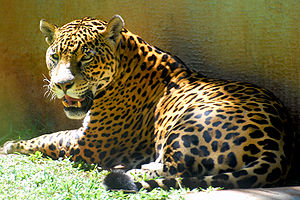
Picture from Wikipedia
This is one of 6 animal tracking caches (plus one more) that is placed on tracking, which are:
- - - Bear Tracking, Mountain Lion Tracking, Bobcat Tracking, Wolf Tracking, Jaguar Tracking, & Coati Tracking.
You must sign the log or your find will be deleted.
Directions & Parking: From I-19 take Exit #40, Chavez Siding Road. Go right (west) for about .1 mile and then go right (north) onto Frontage Road. After .3 miles, go left (N 31 39.405 W 111 03.666) onto Forest Road #640, notice the “Hunter Access Point” sign. A car should be able to go onto FR #640 unless rains have washed some dirt away. You could park at the entrance of #640 (off the tarred road and to the side of the dirt road) which would be about 700 feet from the cache. Continue on FR #640 for about .1 mile, park at N 31 39.352 W 111 03.786 and the cache will be about 200 feet away.
Wildlife Linkages Program, run by Sky Island Alliance, looks for routes Mountain Lions, Bobcats, Bears, Wolves, Jaguars, and Coatis take when they go from one mountain range to another. The mountain ranges are linked by the routes these animals take. The routes (linkages) are found by looking for the animals' tracks in washes between the mountain ranges.
Read more at: Sky Island Alliance http://www.skyislandalliance.org/wildlife.htm.
At Sky Island Alliance, we go out and identify animal tracks, we don’t track the animal.
Jaguar Info
This cache is dedicated to Macho B.; a Jaguar that was captured in southern Arizona in February, 2009 in the Tumacacori mountains. He died 12 days later. Investigations are on-going at this time. Look to the west and you will see the mountains where Macho B. lived..
Size – Jaguars are the largest cat in North America, Central America, and South America. They weigh 124 to 211 pounds (lbs).
Range (where they live) – Jaguars live in Mexico, Central America and South America. A few Jaguars have been documented in southern Arizona, New Mexico, and Texas.
Food (diet) – Jaguars live on deer, foxes, coyotes, snakes, turtles, frogs and small animals.
Population (how many are there?) – Unknown
Life span (how long do they live?) – Jaguars usually live 12 to 15 years in the wild.
Other information – Jaguars have black spots all over their body. The spots are of different shape on each Jaguar so if you study the spot pattern, you can tell one Jaguar from another. The jaguar can roar and makes a sound like a deep cough.
Jaguars have soft paws which help them walk quietly.
Also, they have claws that can come out when they want to climb trees or catch and hold other animals.
Jaguars are very good swimmers and climbers.
They mostly go out at night and can see 6 times better than people.
Welcome to the world of wild animals!
Follow jaguar cubs as they grow up in the rain forests of Central America.
Watch as the small cubs turn into large cats.
Two jaguar cubs are born in the rain forest of Belize.
Their mother has given birth in a well-hidden den.
The cubs are born blind and helpless.
They weigh about 2 pounds (0.9 kilograms).
One of the cubs has yellowish fur with dark spots like his mother.
The other cub has black fur.
The mother licks one cub clean while the other cub drinks milk.
Read more in the book: A Jaguar Grows Up by Amanda Tourville;
This book is in the Pima library system.
Jaguar Prints
|
|
<----Jaguar front track
(track is not the real size)
Real front track size is about 3 to 4 inches long and 3 to 5 inches wide.
Real rear track size is about 2 3/4 to 4 inches long and 2 1/2 to 4 1/2 inches wide.
The front track is larger than the rear track but the tracks are of similar shape.
|
Jaguar Tracing
 |
<---There is a stencil that you can use to trace on paper in the cache. Please excuse the rough stencil. Please do not take the stencil.
|
Read more about Jaguars at:
Jaguar – Wikipedia: http://en.wikipedia.org/wiki/Jaguar
Jaguar Conservation: http://www.azgfd.gov/w_c/es/jaguar_management.shtml
Jaguar: http://www.bluelion.org/jaguar.htm
Jaguar: http://www.belizezoo.org/zoo/zoo/mammals/jag/jag1.html
There is a 7th cache called Wildlife Linkages Tracking Challenge.
[Not valid now-->Don’t forget to get the number in each animal cache under the top cover
to find the Wildlife Linkages Tracking Challenge.

Country flag counter as of Feb 28, 2014

U.S. state flag counter as of Feb. 28, 2014:
